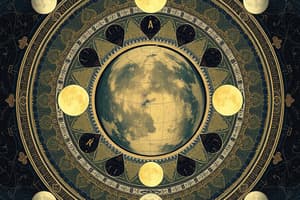Podcast
Questions and Answers
What phase of the Moon occurs right after the Waxing Gibbous phase?
What phase of the Moon occurs right after the Waxing Gibbous phase?
- Waning Gibbous
- Full Moon (correct)
- New Moon
- Last Quarter
How much of the Moon's face is illuminated during the Waxing Crescent phase?
How much of the Moon's face is illuminated during the Waxing Crescent phase?
- Three quarters
- One quarter (correct)
- None
- Half
What is the phase of the Moon when more than half of its face is illuminated by the Sun?
What is the phase of the Moon when more than half of its face is illuminated by the Sun?
- First Quarter
- Waning Crescent
- Waxing Gibbous (correct)
- New Moon
Which phase occurs immediately after the Last Quarter phase?
Which phase occurs immediately after the Last Quarter phase?
In which phase of the Moon is half of its face illuminated?
In which phase of the Moon is half of its face illuminated?
When does the New Moon phase occur in relation to the First Quarter phase?
When does the New Moon phase occur in relation to the First Quarter phase?
What phase of the Moon occurs when the Moon is positioned between Earth and the Sun?
What phase of the Moon occurs when the Moon is positioned between Earth and the Sun?
Which Moon phase is the halfway point of the lunar cycle?
Which Moon phase is the halfway point of the lunar cycle?
During which Moon phase is most of the Moon's face illuminated?
During which Moon phase is most of the Moon's face illuminated?
What does a Full Moon signify in terms of the positions of the Moon and Sun?
What does a Full Moon signify in terms of the positions of the Moon and Sun?
Which phase follows the Waxing Crescent phase in the sequence of Moon phases?
Which phase follows the Waxing Crescent phase in the sequence of Moon phases?
At what phase does the moonlit side face away from Earth, making it difficult to observe?
At what phase does the moonlit side face away from Earth, making it difficult to observe?
Which phase of the Moon is most prominent and noticeable?
Which phase of the Moon is most prominent and noticeable?
During which phase can lunar eclipses occur?
During which phase can lunar eclipses occur?
What characterizes the Waning Gibbous phase?
What characterizes the Waning Gibbous phase?
How is the Third Quarter phase different from the First Quarter phase?
How is the Third Quarter phase different from the First Quarter phase?
What phase marks the beginning of the lunar cycle's reversion toward the New Moon?
What phase marks the beginning of the lunar cycle's reversion toward the New Moon?
What does the changing visual display of the Moon's phases contribute to?
What does the changing visual display of the Moon's phases contribute to?
Flashcards are hidden until you start studying
Study Notes
Phases of the Moon
The phases of the moon refer to the different appearances of Earth's natural satellite when viewed from our planet over time. These changes result from the alignment between the Sun, the Earth, and the Moon. There are generally eight distinct lunar phases, although some astronomers consider there to be nine. Here is a breakdown of each phase and when it occurs relative to the New Moon:
-
New Moon: This happens when the side of the Moon facing Earth is not illuminated by the Sun. It marks the beginning of the cycle of lunar phases, with first quarter occurring exactly half a month later.
-
Waxing Crescent: During this phase, only a small portion of the Moon's visible face is illuminated by the Sun.
-
First Quarter: In this stage, half of the Moon's face is illuminated, hence the name.
-
Waxing Gibbous: More than half of the Moon's face is now illuminated.
-
Full Moon: At this point, the entire face of the Moon reflects sunlight, causing it to appear fully lit from our perspective on Earth.
-
Waning Gibbous: After the full Moon, the lit area begins to decrease, moving us back towards the New Moon phase.
-
Last Quarter: Again, half of the Moon's face is illuminated, just like First Quarter, but it is in reverse order.
-
Waning Crescent: As we approach the next New Moon, only a sliver of the Moon's face remains illuminated, similar to Waxing Crescent.
It's also worth mentioning that there can be a rare ninth phase called the Trespassing Moon. This phase occurs when the Sun and Moon are almost aligned with Earth in a straight line. While it doesn't happen every lunar cycle, it does occur fairly frequently.
Studying That Suits You
Use AI to generate personalized quizzes and flashcards to suit your learning preferences.




